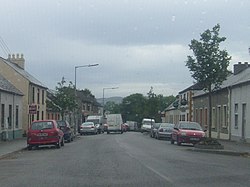Carrigans,_County_Donegal
Carrigans, County Donegal
Village in County Donegal, Ireland
Carrigans (Irish: An Carraigín, meaning "little rock")[2] is a village in The Laggan, a district in the east of County Donegal, Ireland. The village is located on the R236 regional road only a short distance from the River Foyle.
This article needs additional citations for verification. (June 2018) |

